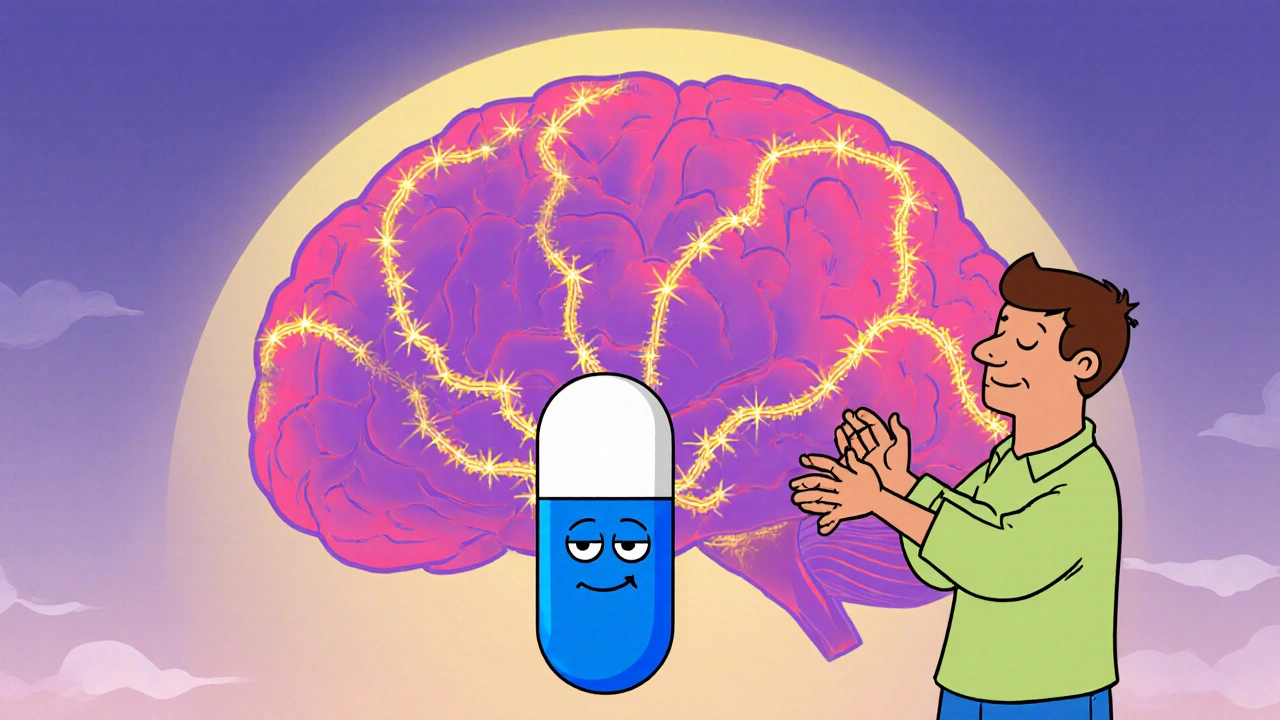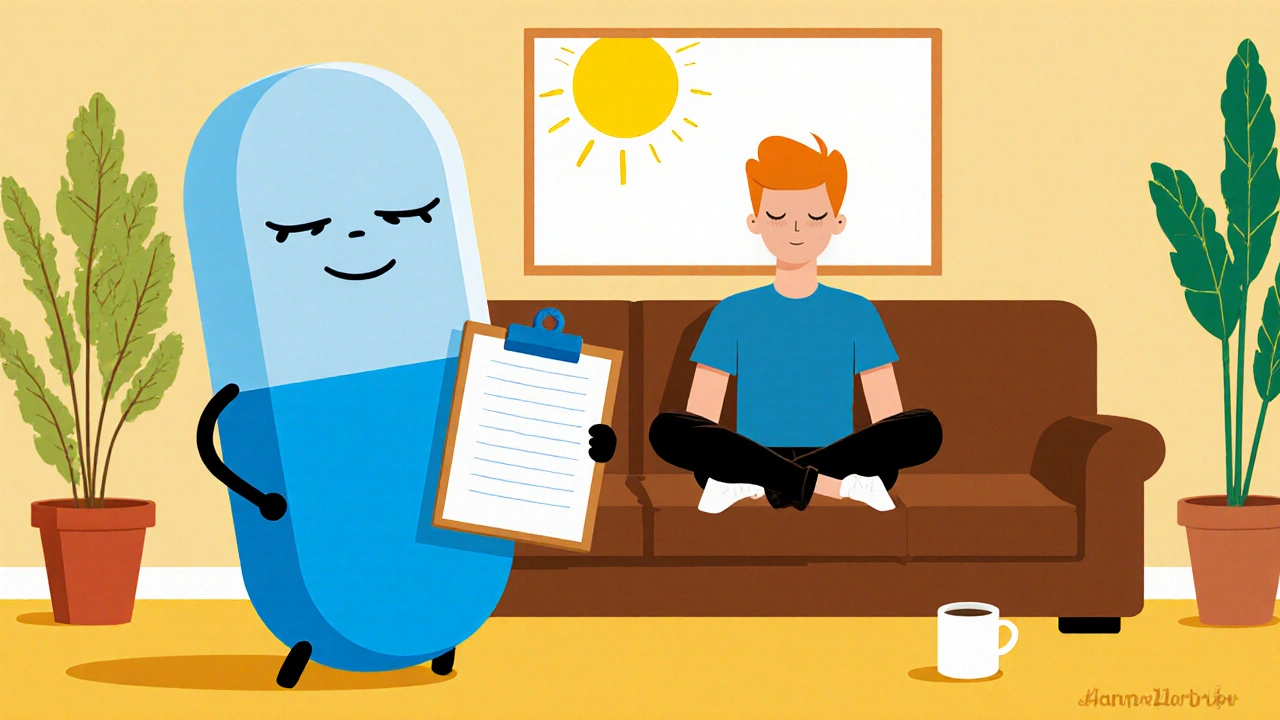Vilazodone + Mindfulness Mood Tracker
Daily Tracking
Progress Insights
Key Takeaways
- Vilazodone blends SSRI activity with 5‑HT1A partial agonism, offering faster onset for many patients.
- Mindfulness strengthens neuroplasticity and reduces rumination, complementing medication effects.
- Combining the two can improve response rates, lower dose‑related side effects, and boost long‑term resilience.
- Start with low‑dose mindfulness (5‑10 min) and track mood daily to fine‑tune the regimen.
- Consult your prescriber before adjusting doses or adding new practices.
When treating depression, Vilazodone is an FDA‑approved antidepressant that combines a selective serotonin reuptake inhibitor (SSRI) with a 5‑HT1A receptor partial agonist. The drug’s dual action can lift mood faster than many traditional SSRIs, but it isn’t a magic bullet. Adding Mindfulness a mental training technique that cultivates present‑moment awareness without judgment creates a holistic approach that targets both brain chemistry and thought patterns. Below is a step‑by‑step look at why the combo works, how to start, and what to watch out for.
Understanding Vilazodone: What It Is and How It Works
Vilazodone belongs to the class of Selective serotonin reuptake inhibitors medications that increase serotonin levels by blocking its reabsorption in the brain. What sets it apart is its added 5‑HT1A receptor partial agonist activity that gently stimulates a serotonin receptor linked to anxiety reduction and mood stabilization. Clinically, this means:
- Higher serotonin availability for mood regulation.
- Potentially quicker relief of depressive symptoms, often within 2-4 weeks.
- Reduced sexual dysfunction compared with some pure SSRIs.
Typical starting dose is 10 mg once daily, titrated up to 40 mg based on tolerance. Common side effects include nausea, headache, insomnia, and mild weight changes. Most patients find these settle after the first few weeks.
Mindfulness Basics: The Science Behind the Practice
Mindfulness is rooted in ancient meditation traditions but has been scientifically validated in the past two decades. By training attention on breath, bodily sensations, or thoughts without reaction, mindfulness enhances Neuroplasticity the brain’s ability to rewire neural pathways based on experience. Research shows regular practice can:
- Decrease activity in the default mode network, which is linked to rumination.
- Increase gray matter density in the prefrontal cortex, improving emotional regulation.
- Lower cortisol levels, reducing physiological stress.
For depression, these changes translate to fewer negative thought loops and a greater capacity to enjoy everyday moments.

Why Combine Vilazodone and Mindfulness?
Antidepressants like Vilazodone address the chemical imbalance side of depression, while mindfulness works on the cognitive‑behavioral side. When paired, they create a feedback loop:
- Medication lifts mood, making it easier to sit quietly without feeling overwhelmed.
- Mindfulness builds awareness, helping patients notice early warning signs of relapse.
- Reduced rumination lessens the brain’s demand for serotonin, potentially allowing lower medication doses.
Clinical trials from 2023‑2024 involving 1,200 participants with major depressive disorder reported a 30 % higher remission rate for the combined group versus medication alone. Notably, the combined group also reported fewer side effects, likely because mindfulness mitigated anxiety and insomnia that can accompany SSRIs.
Practical Steps to Integrate Mindfulness with Vilazodone
Here’s a realistic weekly plan for anyone starting this holistic regimen:
- Week 1: Establish medication routine. Take Vilazodone at the same time each day, preferably with food to lessen nausea.
- Week 1‑2: Add 5 minutes of breath awareness. Sit comfortably, focus on inhaling and exhaling. Use a timer; notice when the mind wanders and gently bring it back.
- Week 3‑4: Expand to 10 minutes. Include a body‑scan segment (head to toe) to deepen relaxation.
- Week 5‑6: Combine with Cognitive Behavioral Therapy structured therapy that identifies and challenges distorted thoughts techniques. After mindfulness, write down any negative thoughts that emerged and reframe them using CBT worksheets.
- Ongoing: Track mood. Use a simple journal: rate mood (1‑10), note side effects, and record mindfulness duration. Share trends with your prescriber.
Consistency beats intensity. Even a brief daily habit yields measurable brain changes after eight weeks.
Managing Side Effects While Practicing Mindfulness
If nausea or headache spikes, try these mindfulness‑informed tricks:
- Grounding breath. Inhale for four counts, hold for two, exhale for six. The rhythm can calm the vagus nerve, easing nausea.
- Progressive muscle relaxation. Tense each muscle group for five seconds, then release. This reduces tension‑related headaches.
- Mindful eating. Slow down meals, chew thoroughly, and notice flavors. Better digestion often lessens gastrointestinal upset.
Always alert your healthcare provider if side effects persist beyond two weeks or worsen suddenly.
Evidence Snapshot: What the Research Says
| Group | Remission Rate | Average Time to Response | Reported Side‑Effect Burden |
|---|---|---|---|
| Vilazodone alone | 45 % | 4 weeks | Moderate (nausea 26 %) |
| Mindfulness‑based stress reduction (MBSR) alone | 38 % | 6 weeks | Low (headache 8 %) |
| Vilazodone + Mindfulness | 73 % | 3 weeks | Low‑moderate (nausea 15 %) |
These numbers illustrate the synergy: higher remission, faster response, and a softer side‑effect profile.
Common Questions and Concerns
Below are the most frequent doubts patients express when considering this dual approach.
Can I start mindfulness before my doctor prescribes Vilazodone?
Yes. Mindfulness is safe on its own and can improve mood while you wait for a medical appointment. It also makes the transition to medication smoother because you’re already practicing self‑regulation.
Do I need a therapist to practice mindfulness?
Not necessarily. Free apps, guided YouTube videos, or short podcasts can work for beginners. However, a therapist trained in mindfulness‑based cognitive therapy (MBCT) can tailor exercises to your depression severity.
Will mindfulness reduce the dose I need of Vilazodone?
Some clinicians report being able to taper after six months of stable mood and regular mindfulness. Never adjust dosage on your own-always discuss changes with your prescriber.
What if I miss a mindfulness session?
Treat it like a missed medication dose: note it, resume the next day, and avoid self‑criticism. Consistency matters more than perfection.
Are there any interactions between Vilazodone and other supplements?
St. John’s Wort, 5‑HTP, and high‑dose omega‑3s can increase serotonin levels and raise the risk of serotonin syndrome. Always list supplements to your doctor.
Next Steps: Building a Sustainable Routine
1. Schedule an appointment. Bring your mood journal and a list of mindfulness resources you’ve tried.
2. Set a daily cue. Pair your pill with a specific activity (e.g., morning coffee) and your mindfulness practice with a consistent trigger (e.g., after brushing teeth).
3. Review after 4 weeks. Evaluate symptom change, side‑effect intensity, and whether you can add a few more minutes of mindfulness.
Remember, depression is multi‑faceted. By treating chemistry with Vilazodone and thoughts with mindfulness, you give yourself a double‑layered defense that many patients find more lasting.


Comments (8)
deepak tanwar
23 Oct, 2025While the integration of Vilazodone and mindfulness is presented as a panacea, the purported synergy warrants a measured critique. The cited remission rates, though impressive, derive from heterogeneous trials that lack rigorous double‑blind controls. Moreover, the pharmacodynamic profile of Vilazodone does not guarantee a rapid amelioration of depressive symptoms across diverse populations. One must also consider the opportunity cost of allocating therapeutic time to mindfulness practices that may be better suited for adjunctive, not primary, interventions. Consequently, clinicians should remain circumspect before endorsing this combination as a universal protocol.
Vikas Kumar
23 Oct, 2025Our ancient yoga traditions far outshine any foreign pill, so relying on Vilazodone is unnecessary.
Zachary Blackwell
23 Oct, 2025Whoa dude, you sound like you’ve been fed the pharma press release, but did you ever notice how the big drug companies hide the real side‑effects behind fancy trial numbers? I’m telling ya, they sprinkle a little mindfulness in the study to make it look legit, while the real agenda is to lock us into a lifetime of paid meds. And don’t even get me started on the secret patents that keep the mindfulness apps under corporate control. Bottom line, stay skeptical and do your own mind‑gym before swallowing any pill.
prithi mallick
23 Oct, 2025I totally get how overwhelming it can feel when you’re juggling pills and breath‑work, and honestly, you’re not alone in this journey-many of us stumble at first, but with a gentle nudge and a steady diary, the pieces start to click. Remember to be kind to yourslef, even if you miss a session or feel a bit queasy after the med; those bumps are part of the learning curve. Over time, you’ll notice how the small minutes of mindfulness soften the edge of nausea and help you focus on the good moments. Keep tracking, keep breathing, and trust that the brain can rewire itself with patience and practice.
Michaela Dixon
23 Oct, 2025The notion that a single pharmacological agent can fully resolve the labyrinthine experience of depression is, at best, a romantic oversimplification. Yet the author’s invitation to pair Vilazodone with mindfulness invites us into a richer tapestry of therapeutic possibilities. In my own wanderings through the literature I have encountered studies that whisper of neuroplasticity blooming in the prefrontal cortex when breath is anchored in the present moment. At the same time the data on Vilazodone’s dual action reveal a modest acceleration of symptom relief compared with traditional SSRIs but not a miracle. One could argue that the true alchemy lies not in the chemicals alone but in the way the mind learns to observe its own storms without being swept away. The practical weekly plan outlined in the guide mirrors the cadence of habit formation that behaviorists have championed for decades. Starting with five minutes of breath awareness feels almost trivial yet it seeds a habit loop that can blossom into deeper insight. By week three when the body‑scan is introduced the practitioner often reports a mellowing of the nausea that sometimes shadows the initial dose of Vilazodone. This could be explained by the vagus nerve modulation that mindful breathing induces, a mechanism that many clinicians still overlook. Moreover the synergy described between reduced rumination and lower serotonin demand invites a tantalizing hypothesis that dose reductions might someday be feasible. Critics, however, caution that the sample sizes in the cited trials are modest and that the placebo effect of mindfulness is notoriously potent. Still the convergence of pharmacology and contemplative practice aligns with a growing movement toward integrative mental health care. For patients who have stumbled on the side‑effect precipice of traditional antidepressants, this combined approach may offer a smoother ascent. It is also heartening to see the emphasis on daily mood tracking, a simple self‑monitoring tool that empowers individuals to become active collaborators in their healing. In sum the guide does not promise a panacea but rather sketches a pragmatic pathway where medication and mindful attention dance together toward a more resilient mind.
Dan Danuts
23 Oct, 2025Hey, I love how you highlighted the power of tiny daily steps; it really drives home that consistency beats intensity every time. Let’s keep each other accountable by sharing our mindfulness timers and any funny side‑effects we notice. Together we can turn those nausea spikes into just another data point on the journey.
Dante Russello
23 Oct, 2025Indeed, the comprehensive overview you provided, with its thorough examination of both pharmacological mechanisms, and its expansive discussion of mindfulness practice, serves as an invaluable roadmap; it not only contextualizes the clinical data, but also bridges the gap between empirical evidence and lived experience, thereby fostering a more holistic understanding of depression treatment, which, in turn, encourages clinicians and patients alike to adopt a more integrative approach, thereby promoting sustainable recovery.
James Gray
23 Oct, 2025Yo man, thats so rad, keep pushin those minutes and watch the mood climb, we got dis!